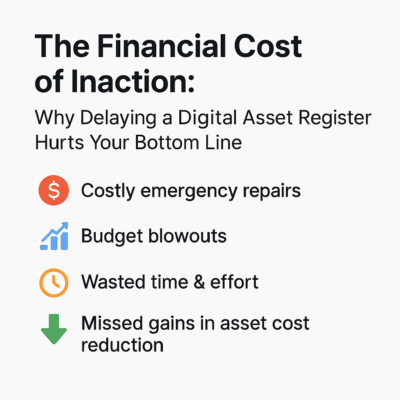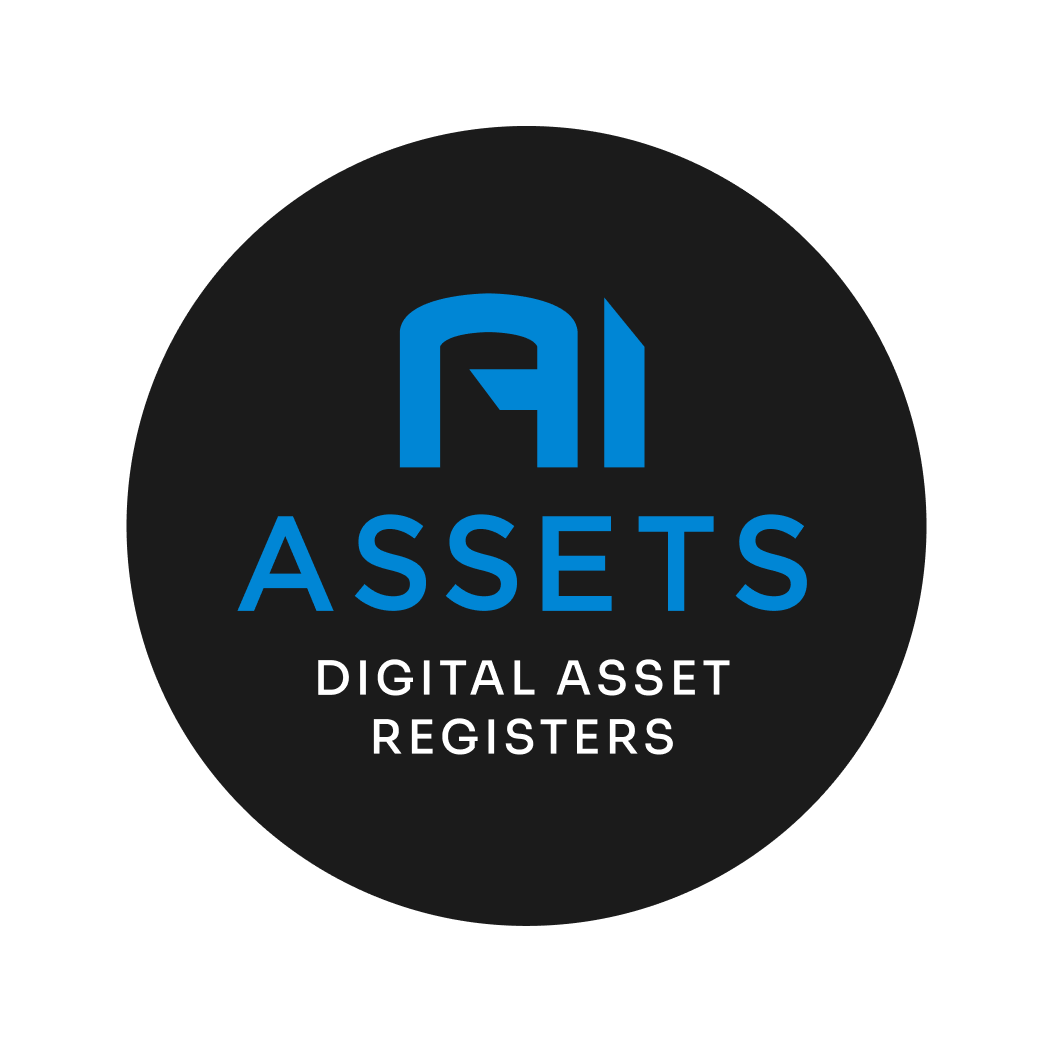Introduction: The Hidden Price of Outdated Asset Records
In property and facility management, doing nothing can be expensive. Relying on outdated or incomplete asset records might seem “good enough” day-to-day, but it carries a hefty hidden price tag. According to a PwC analysis, mismanaged physical assets cost businesses around the world an estimated $17 billion per year in losses, unnecessary maintenance, and non-compliance. Shockingly, 81% of small and mid-sized companies admit they do not have an accurate view of their assets – let alone a comprehensive asset register. This lack of accurate, live asset data means many property and facility managers are essentially flying blind. The result? Inefficiencies, surprise repairs, budget overruns, and missed opportunities that compound over time into significant financial risks. In line with the mission of turning physical building assets into a quality, live digital asset register, this article examines the financial cost of inaction. We’ll break down how delaying the adoption of modern digital tools for asset management leads to real, measurable costs in four key areas: operational inefficiencies, unplanned repair expenses, poor capital forecasting, and lost lifecycle optimisation.

Operational Inefficiencies and Hidden Costs
Outdated management methods – like scattered spreadsheets, paper files, or siloed databases – create daily inefficiencies that quietly drain resources. Maintenance teams often waste hours searching for basic asset details or tracking down service histories due to disorganised records. In fact, as of a few years ago, 55% of facilities were still using spreadsheets and schedules, and 44% relied on paper for maintenance tracking. These manual processes translate into higher labour costs and slower response times. For example, without a centralised digital asset register, different departments might duplicate data entry, or technicians may spend extra time verifying equipment information before performing work. All this is lost productivity – paid staff hours that yield no value. Over a year, those hours add up to a significant cost.
Beyond wasted time, incomplete asset data often means inefficient use of resources. You may end up over-purchasing spare parts because the inventory isn’t tracked or paying for tools and equipment you already have but cannot locate. One study note that poor asset data can lead to “ghost assets” – equipment that is lost, stolen, or inactive but still on the books – which skews financial records and wastes money on insurance and taxes for non-existent items. Similarly, limited visibility into asset status can cause you to keep under-utilised assets in service (tying up capital) or miss when critical assets are underperforming. All these inefficiencies directly impact the bottom line. As Expansive FM observes, if you’re juggling multiple Excel files or outdated systems, chances are you have no real overview or control, and it’s already impacting your bottom line. In short, sticking with outdated asset record-keeping creates a continuous operational drag on your organisation – a drag measured in labour hours, redundant purchases, and management headaches that cost real dollars.
Unplanned Repairs: The High Price of Reactive Maintenance
One of the most immediate financial hits from poor asset tracking is the cost of unplanned repairs. Without a live digital asset register to support preventive maintenance, organisations default to a reactive approach – fixing things only when they break. This “run-to-failure” strategy is notoriously expensive. Studies show that running a piece of equipment until failure can cost up to 10 times more than performing regular preventive maintenance would have. The reasons are clear: emergency callouts, rush shipping for parts, overtime labour, and disrupted operations all carry premium costs. Unplanned breakdowns often occur at the worst times, requiring immediate fixes “at any cost.” For instance, maintenance experts note that when critical equipment fails unexpectedly, organisations pay extra for expedited parts and incur overtime labour costs for crews working after-hours to get systems back online. These emergency repairs and rush fees can quickly blow through maintenance budgets.
Inaccurate or outdated asset information also makes it harder to schedule timely preventive maintenance, so small issues are missed until they escalate. As a result, facilities suffer more downtime and surprise breakdowns. In effect, poor asset data creates a vicious cycle: it “leads to inefficiencies in scheduling preventive maintenance, resulting in downtime, unexpected breakdowns and often costly emergency repairs.” Beyond the direct repair bills, the ripple effects of system failures – think of a building’s HVAC collapsing on a hot day – might include lost tenant productivity, unhappy occupants, or even temporary facility closure, all of which carry financial consequences.
The difference in cost between reactive and proactive maintenance is striking. According to the U.S. Department of Energy, predictive maintenance (using modern monitoring and data) saves up to 40% over reactive maintenance costs. Real-world examples back this up. Consider a global grocery retailer whose facilities management was primarily reactive, fixing equipment only after failures. This approach caused frequent store disruptions and skyrocketing repair costs. They lacked asset visibility to decide whether to repair or replace aging equipment, meaning they often poured money into emergency fixes without a long-term plan. After adopting a centralised digital facilities platform and shifting to scheduled maintenance, the retailer saw dramatic savings – about $14 million in cost reductions, a 19% drop in average work order costs, and 97% asset uptime. The lesson is clear: continuing in reactive mode is like burning money. The cost of inaction on implementing a digital asset register (which enables preventive and predictive maintenance) is measured in every avoidable repair bill and every hour of downtime that could have been prevented.
Poor Capital Forecasting and Budget Surprises
Delaying the move to a digital asset register doesn’t just affect day-to-day operations – it undermines long-term capital planning. Facility and property managers need accurate data on asset age, condition, and lifecycle to forecast when big-ticket replacements or upgrades are coming. Without this, you’re budgeting in the dark. Outdated or incomplete asset records often lead to surprise capital expenses that blow budgets. Imagine a building’s chiller or roof that quietly exceeded its expected life because no one had a reliable record of its install date or condition. The failure of that asset will demand an unplanned capital outlay of hundreds of thousands of dollars with little warning. Many organisations face “unplanned costs” simply because they have “no clear insights into asset depreciation, maintenance needs, or upcoming replacements.” In other words, poor asset data means you don’t see the big expenditures coming until they hit hard.
The financial impact of this lack of foresight can be huge. Deferred maintenance – when minor fixes or replacements are put off due to poor planning – tends to compound into larger costs later. Research has quantified this effect: every $1 of maintenance deferred can quadruple to $4 in capital repair costs down the line. Inaction essentially accrues interest, as small issues expand into major capital projects. Additionally, without a quality asset register aligning with accounting, there’s often a misalignment between asset records and financial statements. Assets might be fully depreciated on paper yet still in use (and prone to failure), or conversely, assets that no longer exist might still be carried on the books. This obscures the true state of asset renewal needs and can lead to either over-spending or under-budgeting in capital plans.
Poor asset information also hampers repair-versus-replace decisions. A live digital asset register, paired with condition data, helps forecast when it’s more cost-effective to replace an asset than to continue repairing it. If you don’t have that data, you might sink money into keeping an inefficient, end-of-life machine running, not realising a new unit would save money over the long run. As one facilities director put it, lacking asset data is like not knowing when to stop throwing good money after bad. This uncertainty forces conservative (often higher) budgeting “just in case,” tying up capital that could be used elsewhere. Or worse, it results in underestimating needs and then scrambling for funds or emergency financing when something critical fails. Neither scenario is good for the balance sheet. In summary, inaction on digitising your asset register leads to poor capital forecasting, which directly translates to financial instability – from surprise expenditures to inefficient allocation of capital resources.
Missed Opportunities in Asset Lifecycle Management
Perhaps the most overlooked cost of maintaining incomplete asset records is the opportunity cost – the money you could be saving or gaining if your asset management were optimised. Modern digital asset registers do more than inventory assets; they enable data-driven asset lifecycle management. This means tracking an asset from purchase and installation through maintenance, and eventually to replacement or disposal, with full visibility into performance and costs along the way. Without this, property and facility managers are missing chances to extend asset life, reduce operating costs, and make strategic improvements.
For example, with no live register to log detailed maintenance history or real-time condition data, an organisation might under-maintain or over-maintain equipment. Both have financial downsides. Under-maintenance leads to higher failure rates and shortened lifespans (meaning more frequent expensive replacements), whereas over-maintenance wastes resources on too-frequent servicing or part replacements that aren’t actually needed. A well-kept digital asset register helps find the “Goldilocks” zone of maintenance – just the right amount to maximise life at minimal cost. Without it, assets either wear out faster or cost more to keep running, and in both cases the company loses money.
Additionally, lacking good data means losing out on optimisation opportunities. Facility managers today use digital tools to analyse energy use, downtime patterns, and performance metrics of building systems. Poor asset information management can hide the fact that, say, an HVAC unit is consuming 20% more energy than it should because it’s aging or malfunctioning. Consequently, you miss the chance to retrofit or replace it proactively to save on utility bills. It’s noted that poorly maintained assets often consume more energy than necessary, driving up energy costs – a preventable expense if assets are tracked and cared for optimally. Likewise, without insight into asset performance, you might not realise that a $5,000 component upgrade on a critical system could extend its life by five years, yielding a high return on investment. These optimisations are the “low-hanging fruit” that a digital asset register helps identify; ignoring them is like leaving money on the table.
There’s also a revenue side to this equation. Reliable asset records contribute to smoother operations, better service quality, and even improved client/tenant satisfaction – factors that can affect revenue. For instance, a commercial building with well-maintained systems (backed by a live asset register) provides a more consistent environment for tenants, whereas one with frequent outages (due to reactive maintenance) might see tenants leaving or demanding rent concessions. In the long term, a building with a documented, well-managed asset history can command higher resale value because buyers see lower risk and better upkeep. In fact, lacking proper asset documentation can “erode tenant trust and damage brand reputation,” potentially even leading to lost revenue when it comes time to sell or transfer a property. Conversely, one study found that companies maintaining accurate asset registers improved their revenue and cash flow by 5–18% by squeezing more value from their assets. If you delay implementing a digital asset register, you are effectively forfeiting these gains. The cost of inaction here is the opportunity cost of all the savings and additional revenue you fail to capture through optimised asset lifecycle management.
Compounding Financial Risks and Long-Term Consequences
The financial impacts of inaction don’t just hit once – they accumulate and compound over time. Each year that passes without a digital asset register in place, the inefficiencies, unplanned costs, and missed opportunities stack on top of one another. Think of an ignored maintenance issue that grows worse each month, or outdated data that becomes harder to reconcile the longer you wait to fix it. A building operator might get away with manual processes for a while, but as the asset portfolio grows and ages, the risk of a major costly failure increases. Small annual losses from inefficiency can suddenly swell when multiple systems start failing unexpectedly due to years of suboptimal upkeep. In financial terms, it’s similar to accumulating debt: the longer you delay addressing it, the more interest (or in this case, extra cost) you pay.
There are also compliance and regulatory risks to consider. In an era of tightening building regulations and safety standards, having up-to-date asset information is essential. Continuing with incomplete records could mean missing inspection deadlines, warranty expirations, or safety recalls. The result might be fines, penalties, or expensive legal liabilities – costs that far exceed the investment in a proper asset management system. Poor asset documentation has been cited as a factor that exposes owners to regulatory risks and potential penalties. For example, if a critical building system fails and injures an occupant, investigators will want to see maintenance records. Incomplete logs could increase liability. Thus, inaction not only risks operational costs but opens the door to financial risk from non-compliance or safety issues – truly high stakes for any property manager.
Finally, consider the cost of catching up later. Sooner or later, organisations that postpone digital asset management realise they must modernise (often after a costly incident or audit finding). At that point, playing catch-up can be an enormous project: hiring consultants to do a complete asset inventory, trying to piece together years of missing data, and retraining staff under urgent timelines. One report noted that recreating an asset register for a building after the fact (via surveys and walk-throughs) can take up to 90 days of effort – time during which you’re paying for surveys and potentially operating in limbo. The irony is that implementing a digital asset register earlier is far cheaper and smoother than emergency backfilling it later. The longer you wait, the higher the upfront cost when you finally do act, because you have more mess to clean up.
Conclusion: Investing Now to Save (and Earn) in the Future
Facility and property managers are often tasked with controlling costs – and that includes recognising when “saving” on technology today leads to bigger expenses tomorrow. Continuing to rely on outdated, incomplete asset records is a prime example of false economy. The financial cost of inaction is felt through labour inefficiencies, excessive repair bills, unreliable budgeting, lost savings opportunities, and increased risk. These costs are not abstract or inevitable; they are the direct result of a choice to stick with the status quo. The good news is that the opposite choice – adopting a modern, centralised digital asset register – turns those liabilities into gains. With a quality, live digital asset register, managers gain real-time visibility into assets, enabling preventive maintenance that avoids costly breakdowns, accurate data for budgeting and capital planning, and insights that optimise each asset’s performance and lifespan. In short, a modern asset management platform helps ensure every dollar spent on your building assets is deliberate and yields value, rather than plugging holes caused by missing information.
The mission of “turning physical building assets into a quality, live, digital asset register” is about empowerment: giving managers the tools to make data-driven decisions that save money and add value to their properties. From the case studies and data, it’s clear that the longer you wait, the more you pay in the long run. On the flip side, early adopters of digital asset management are seeing significant ROI in cost savings, extended asset life, and smoother operations. For property and facility professionals, the path forward is persuasive and practical – invest in robust digital asset register solutions now and avoid paying the steep price of inaction. Your bottom line will thank you for years to come.
Sources: The insights and data in this article are supported by industry research and case studies, including findings from PwC on global asset losses, facility management analyses on maintenance cost differentials, and real-world examples of cost savings through proactive asset management, among others. These illustrate that moving to a live digital asset register isn’t just an operational improvement – it’s a smart financial strategy to avoid compounding risks and unlock long-term value.


